One of life’s greatest innovations is the internet, or at least it should be. Unfortunately, not everyone has access to all of the information on the internet. Since not everyone is able to utilize the internet in the traditional sense. Digital accessibility is crucial.
Simply said, digital accessibility refers to making sure that visitors of your website and other digital information can navigate, use, interact with, and consume them despite obstacles. However, occasionally web designers, content producers online, and developers fail to take accessibility difficulties into account. Consider the following tips to make sure your website is accessible to everyone.
Write in Clear and Plain Language
All users, especially those with cognitive impairments and limited reading skills, can grasp your material by using plain or basic language. It’s essential to work with a digital accessibility team to ensure your language hits the mark. Quite often, we understand what we’re trying to say or what we’ve written, but someone else might have a difficult time with it. Highlight the advice below to ensure you’re headed in the right direction.
There are software platforms that allow you to check for clear and plain language if you’re not sure how your content sounds.
Prioritize crucial information.
- Use words that your audience will understand.
- Use simple words and phrases as much as possible.
- Always define technical phrases or, if at all feasible, refrain from using them.
- The passive voice should be avoided. Instead, use the active voice to make your statements more understandable by giving them a distinct “actor.”
Subtitle videos and audio.
Not everyone uses the traditional methods when processing information online. For example, people with hearing disabilities won’t be able to access the information in films and sound bites. They will be able to grasp the information you are presenting on your website if you include captions to the video and audio.
- Single captions, subjects, and phrases should be combined.
- Speakers should have labels.
- Captions should show at the same time as the audio.
- Describe sounds like a knock, a doorbell ringing, and gunfire that can be heard but not seen.
Make it simple to navigate your content.
It’s not enough to just add text to videos and audio elements to make a website accessible. It also pertains to how simple it is to traverse your content.
Divide the text into parts. Any reader may become overwhelmed by too much content. You are not required to restrict the amount of information on your website as a result. Users can navigate directly to the area they want to read if you make it simple for them to skim over text blocks they aren’t interested in reading. Just be careful to organize your content’s breakdown logically.
Use different headings.
Readers will find it simpler to understand your text’s structure if you use headings. However, it will also make it simpler for users of assistive technology, such as screen readers, to navigate between parts and find what they need.
Correct all of the paperwork. You must ensure that all of your online papers are available. Remediation is the process of assessing current PDFs and other kinds of documents in light of accessibility guidelines. This implies that any PDFs and other papers you have can be viewed by people who have cognitive problems as well as utilizing assistive technology. A table of contents, headings, alternate text for images, and tags are all added during this step.
Add detailed alternative text.
Alternative (alt) text is used because not everyone can see images. For users who are blind or visually impaired, alt text—also known as alt attributes and alt descriptions—is a brief written description of an image. When an image doesn’t load, it might also be utilized in its place.
Users that use screen readers will be able to grasp your material if you add brief but detailed alt text to each image on your website. Without alt text, some viewers may choose to ignore these photos or attempt to determine your content from the file name of the image.
As with your content, make sure your alt text is relatable and clearly understandable. These little details really add up in the end, and make sure your information is as digitally accessible as it can be.
In order to properly add alt text, be sure to:
If you can, include keywords in the alt text. Alt text benefits more than just accessibility. In particular, when it comes to Google, pictures can aid with search engine optimization (SEO). Your website’s traffic may increase if you use alt text to help you rank higher in Google pictures.
Be succinct and precise. Particularly for individuals who use a screen reader, reading lengthy alt text might be a pain. It is best to be brief and direct. You should also use accurate alt text. Avoid overusing keywords and becoming redundant with your information.
Examine (and correct) color contrast.
The impact of color contrast on your website’s accessibility is significant. People’s perceptions of and interactions with the material on your website are influenced by color contrast.
When creating a website, web developers and designers frequently consider the colors that are most appealing to or relevant to your brand. The colors selected should have sufficient contrast to allow a user to distinguish between the text and the background.
How do you measure color contrast, then? First of all, a visual check cannot be used to accomplish this. Everybody’s eyes see things differently, especially color. Your eyes can fool you even if you have good vision.
Use a color contrast checking tool, such as WebAIM’s Contrast Checker to complete this task correctly. The contrast ratio of text and text pictures should be at least 7:1 in accordance with the Web Content Accessibility Guidelines (WCAG) 2.1 standards, with the exception of large-scale text and associated images, which should have a contrast ratio of at least 4.5:1.
Digital Accessibility Allows More People to Use Your Website
All users, irrespective of their ability, are able to access and utilize online material thanks to web accessibility. It’s critical that online designers, content producers, and developers make an effort to understand what makes a website accessible to all users.
At QualityLogic, we make the process of assessing and transitioning your systems to digital accessibility easy. We provide a variety of testing services as well as technologies, tools, and training for all of your digital accessibility needs. To learn more about our services, visit our website at qualitylogic.com.
Author Bio:
LitSpark Solution is one of the best web development and resource hiring agency in US. Hiring dedicated developers and web developers from LitSpark gives you access to experts who know the most advanced tools and technologies to help grow your business.






